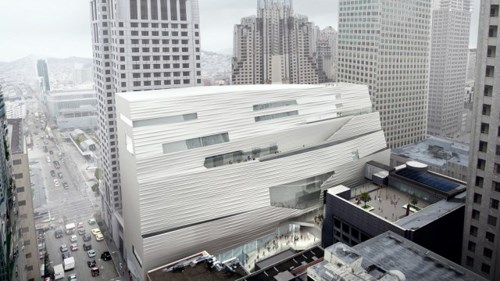Warm thoughts about architecture in cold weather
Composite materials have come a long way in the architecture world and are now poised to be a major player in this high-profile, high-growth industry.

Semi-structural composite panels are playing a big role in the design and construction of the San Francisco Museum of Modern Art.
Sitting here looking out at the snow is making me think of warmer places. Warmer places brings to mind Florida – and the first time I went to Florida to cover a trade show, ACMA’s (then CFA’s) Composite 2001 in Tampa. That was when I met Bill Kreysler of Kreysler and Assoc., and nervously attended a meeting of the ACMA’s Architectural Division. My knowledge of composites was still very rudimentary at that point, and I hadn’t thought much about the use of composites in architecture, but Composites Technology magazine had run a story on fiberglass architectural decorative elements in 1996, and another in October 2000, about the use of composites to seismically upgrade the Marin County, CA, US, government building designed by Frank Lloyd Wright.
That 2001 Division meeting sparked an enduring interest in composites for architecture and civil construction, for me, and led to many conversations with Kreysler and others, which in turn resulted in some great articles over the ensuing years — articles on bridges, buildings, Denver’s giant bear sculpture, and later, fire safety, building code changes and architectural facades and building elements being embraced worldwide. The picture above shows Kreysler’s façade for the San Francisco Museum of Modern Art that’s currently under construction.
It is gratifying to look back over the past 14 years and see just how far this market sector has come. In addition to generating great story topics, ACMA and the Architectural Div. have made important progress in ensuring the inclusion of composites in building codes. I don’t believe I’ll soon have a repeat of the telephone call to a New York-based architect, at least 10 years ago, for a story. When I asked his view on composites usage in commercial buildings, he replied, “I’ll never use composites in a building.”
This topic has already been covered extensively by several CW writers, including my colleague Ginger Gardiner, who posted an interesting blog a couple of months ago about an event at the University of Southern California’s School of Architecture. She also visited and reviewed the ACMA Architectural Div.’s exhibit at the 2014 American Institute of Architects’ (AIA) national meeting, a “Composites Pavilion” in the exhibit hall that provided information for architects and designers about composite materials. That event was the springboard for the introduction of some really significant new products, including the new foundation wall system from Epitome. The group will mount another, larger Composites Pavilion at the 2015 AIA conference.
Ashland Performance Materials has been instrumental in helping to promote the growth of architectural composites, including development of a Web site called Compositebuild.com. The site is an informational hub that seeks to connect architects and builders to composites, and offers educational pages, case studies and links to composite firms and best practices. Another resource showcasing the reach of composites into architectural design is a blog called Composites and Architecture, an inspiring and visually stunning site built by Kreysler and Assoc. with input from contributors around the world. It shows how composites are currently being used in buildings as well as in artistic design.
The point of all this is this: Composites have made great strides in buildings and architecture because of the hard work of some industry champions to get the word out. It’s all about increasing awareness, offering education, explaining the technology, overcoming prejudices, discussing total lifecycle costs and increasing interest level in a community so that material and fabrication costs can come down as demand increases. The fact that recent building code changes allow use of composites means that architects and designers need to get up to speed on our materials and how they can be applied, to great benefit. As I wrote in my February 2013 architectural article, a well-known architect (who happens to be a neighbor of mine) said, “Architects are always intrigued by new materials. If they can perform and meet code and provide some unusual capability, then it’s worthwhile, despite added cost.”
Good to write about a hot composites trend on a very cold, snowy day.
Related Content
CCG meets customer demand with StormStrong utility pole lineup
Additional diameters build on the portfolio of resilient FRP pole structures for distribution and light pole customers.
Read MoreGatorbar, NEG, ExxonMobil join forces for composite rebar
ExxonMobil’s Materia Proxima polyolefin thermoset resin systems and glass fiber from NEG-US is used to produce GatorBar, an industry-leading, glass fiber-reinforced composite rebar (GFRP).
Read MoreCSub delivers one-piece composite truss bridge in Norway
EPC supplier has fabricated, transported and delivered a 42-meter composite bridge intended for pedestrians and bicyclists.
Read MoreCirculinQ: Glass fiber, recycled plastic turn paving into climate solutions
Durable, modular paving system from recycled composite filters, collects, infiltrates stormwater to reduce flooding and recharge local aquifers.
Read MoreRead Next
VIDEO: High-volume processing for fiberglass components
Cannon Ergos, a company specializing in high-ton presses and equipment for composites fabrication and plastics processing, displayed automotive and industrial components at CAMX 2024.
Read MoreAll-recycled, needle-punched nonwoven CFRP slashes carbon footprint of Formula 2 seat
Dallara and Tenowo collaborate to produce a race-ready Formula 2 seat using recycled carbon fiber, reducing CO2 emissions by 97.5% compared to virgin materials.
Read MoreDeveloping bonded composite repair for ships, offshore units
Bureau Veritas and industry partners issue guidelines and pave the way for certification via StrengthBond Offshore project.
Read More






















